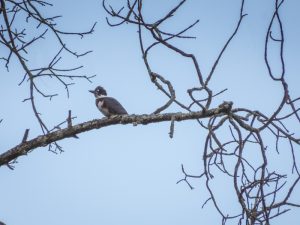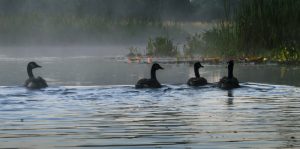Water Closet for August 11, 2017
Seven paddlers including the Old Closeteer arose in the dark and wondered for a moment why they were doing so. It was four-o’clock; sunrise, their target, was at five-thirty. They planned to greet the sun’s early light on the Great Wenham Swamp, a vast impoundment above the Willowdale Dam on the Ipswich River. [pullquote]”The swamp may be quite like it was four centuries ago before the Indians killed beavers for the new comers from across the sea who paid iron pots and knives for their pelts”[/pullquote]Once on the road to their put-in spot off the Topsfield-Ipswich Road they cheered up and upon arrival joked as they lugged a canoe and five kayaks down to the river a quarter mile above the Willowdale-Foote Dam where a woolen mill once made clothing for the Union Army. No wool was needed on this late-July sunrise-paddle day. The cool air was dry and clear; the water flowing high and fairly fast. Almost two inches of rain had fallen two days before. At five-thirty, at least human-wise, the seven had the lovely river to themselves.

Early morning “sea smoke” surrounds paddlers on the Ipswich River. – Judy Schneider photo
But others were there in great numbers; the fish below unseen, song birds above, and geese and ducks on the surface. The first sights that thrilled the paddlers were patches of fog no more than head high on the water. It is called sea smoke on the ocean. The water vapor rising in cool air condensed and gave us quite a show. These low clouds glowed in the reflected light from the sun still beyond the high greenery of the river’s walls. Light above in the trees plus that reflected up from the still water provoked a wondrous mood they’ll not forget. If they do their photographers, who caught some, can pull them down from cyberspace. All happily dawdled to allow the three photographers to take shots in the magic light. The shutter bugs were kidded about lagging. Those without cameras just marveled at the scenes that included flowering white and yellow water lilies, button bushes, pickerel weeds, smart weeds, reed-canary grass, and now and then wild-rice to mention but a few plants flourishing in the wetlands. Within a half-hour the patches of fog on the water were gone and new phenomena caught their eyes. Large spider’s webs between the twigs of swamp dogwood and button bushes and high up in dead maples glowed silver in the stronger light. They, full of dew, sparkled. Yet in an instant due to a change in angle they completely disappeared like sand paintings swept away upon completion by their makers. They knew the webs were still there, but could they be sure? Or were the webs the spiders’ morning offerings to the sun god and not just lovely catchers of prey?

The belted kingfisher’s loud long chatter as he flies from perch to perch is always a welcome wakeup call for river travelers. – Judy Schneider photo
Such whimsical wonderings were theirs as they happily chatted and pointed out things while passing. The photographers, usually astern in their wakes, captured some of what they’d seen and stored it digitally. As the sun rose higher the shade lessened as the fleet left the tree canyons and paddled out into the open scrub-shrub swamp dominated by canary grass, cattails, button bushes, bur-reed, smart weed, and dying silver maples. The numerous beaver dams they passed over have exacerbated the effect of manmade Willowdale Dam. Together for the past two decades these dams have been drowning the venerable old maples and swamp white oaks which like water but can’t take so much year ‘round.
The areas of the dams’ impoundments are impressive. The Great Wenham Swamp, originated long ago as a mill pond behind the Willowdale Dam, for two centuries it has flooded almost four square miles (about 2800 acres) of what was once wet meadow. The addition of a dozen beaver dams since the late 1990s put several hundred more acres around its edges under water. Dying trees are seen all along the four miles of meandering river from High Street (Route 97) to Asbury Street in Topsfield. The fallen and leaning giants, without twigs and leaves, are unintended victims of the beavers. Passers by who think they know the history of the scene are not much saddened. The swamp may be quite like it was four centuries ago before the Indians killed beavers for the new comers from across the sea who paid iron pots and knives for their pelts. After the beavers were gone the colonists drained the rich beaver meadows so they could hay and pasture them in late summer. Then mill builders came and damned the rivers for water power. After the Civil War the farmers gradually moved west or into area factories. But it was not until 1996 that steel leg hold traps were banned and the beavers came back. The Closeteer guesses from his knowledge of Middleton’s eight miles of Ipswich River that there may 30 to 40 beaver dams between the headwaters in Wilmington and tidewater in downtown Ipswich. There are three manmade dams standing.

Canada geese quiet on calm Ipswich River water before the early morning mist is gone. – Judy Schneider photo
As the Closeteer paddled with his companions in the perfect light of another new day he thought of beaver meadows, hay fields and pastures, and mill ponds for power. He and the others were also much impressed by other evidences of energy being captured. As the sun rose after a cold night like so many this summer, the turtles came out in numbers and parked on emergent logs with their dark solar panels towards the sun. On the paddle back, when the sun’s altitude was at about 45 degrees turtles, hundreds of them, single or little groups were seen along the west bank on floating and leaning logs and snags their faces pointed up and out; their dark backs at near right angles to the blood warming sun’s rays. The paddlers passed within a few feet of many, closer than they could upriver. Their hypothesis was that in the Great Wenham Swamp turtles are much more used to canoe and kayak traffic up from Foote’s Canoe and Kayak Rental at the Willowdale Dam and thus not as shy.

Four painted turtles position themselves on a log to catch the early morning light. – Judy Schneider photo
The turtles were not the only ones being recharged that morning. Despite over five miles of paddling, sometimes against current over submerged beaver dams, the paddlers’ energy and spirits were high. At the end, their vessels were pulled out and toted up the bank and on to vehicles with vigor and good cheer. Any muscle fatigue wasn’t acknowledged, only some regret upon leaving such a lovely scene. Near the end the paddle the first rental canoe from Footes passed them going up river. The veterans wished its two paddlers well knowing they too were being recharged.
The turtles sense the energizing sun each day. The Stream Teamers and friends realize the Ipswich River is nearby and now navigable year-around thanks to beavers holding back the water. The Indians of long ago were well aware of this. Each year in May before the big migration-blocking industrial dams they greeted millions of anadromous fish up from the ocean to spawn. Present paddlers’ descendants might see the fish again when the manmade dams are gone or modified. What a renewal that would be to human spirits and more essentially to fish!
__________________________________________________________
WATER RESOURCE AND CONSERVATION INFORMATION
FOR MIDDLETON, BOXFORD AND TOPSFIELD
| Precipitation Data* for Month | May | June | July | Aug. | |
| 30 Year Normal (1981 – 2010) Inches | 4.06 | 3.95 | 3.89 | 3.37 | |
| 2017 Central Watershed Actual | 4.87 | 6.08 | 3.8 | .3 as of Aug. 4 | |
Ipswich R. Flow Rate (S. Middleton USGS Gage) in Cubic Feet/ Second (CFS):
For Aug. 4, 2017 Normal . . . 18 CFS Current Rate . . . 17.6 CFS
*Danvers Water Filtration Plant, Lake Street, Middleton is the source for actual precipitation data thru June.
——————————————————————-–
** Middleton Stream Team is the source of actual precipitation data for July..
Normals data is from the National Climatic Data Center.
THE WATER CLOSET is provided by the Middleton Stream Team: www.middletonstreamteam.org or <MSTMiddletonMA@gmail.com>


ng303 hello my website is ng303
unlayer hello my website is unlayer
indgoal hello my website is indgoal
wa7782 hello my website is wa7782
orginal hello my website is orginal
soncold hello my website is soncold
ligabet hello my website is ligabet
parade hello my website is parade
jsvmp hello my website is jsvmp
It was an awesome paddle Pike. Thanks so much, as always.